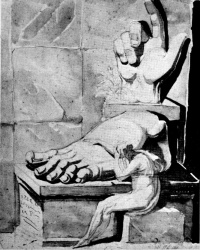Noble simplicity and quiet grandeur
From The Art and Popular Culture Encyclopedia

|
"The chief and universal characteristic of the Greek masterpieces in painting and sculpture consists, according to Winkelmann, if a noble simplicity and quiet grandeur, both of attitude and expression. " As the depths of the sea," he says, "remain always at rest, however the surface may be agitated, so the expression in the figures of the Greeks reveals in the midst of passion a great and steadfast soul."--Laocoon: An Essay on the Limits of Painting and Poetry (1766) by Gotthold Lessing "What a silent admonition has for our restless and artificial world the beautiful , which according to Winkelman , consists in noble simplicity and quiet grandeur. The contemplation of art is the best training for solving difficult ..."--Deterioration and the Elevation of Man Through Race Education (1877) by Samuel Royce "Leblanc, too, like Mariette, preceded Winckelmann in urging a noble simplicity, from which the French of his time had departed"--The Creation of the Rococo (1943) by Fiske Kimball |
|
Related e |
|
Featured: |
"Noble simplicity and quiet grandeur" is a dictum by German art historian Johann Joachim Winckelmann, featured in Thoughts on the Imitation of Greek Works in Painting and Sculpture (1755). It became an adagium of Neoclassicism.
The German original, "edle Einfalt und stille Größe" is commonly translated as "noble simplicity and quiet grandeur" and not "noble simplicity and sedate grandeur" as Henry Fuseli had first translated it. Translator Ellen Frothingham replaced "sedate" by "quiet".
German original
- "Die edle Einfalt und stille Größe der griechischen Statuen ist zugleich das wahre Kennzeichen der griechischen Schriften aus den besten Zeiten."
Fuseli translation:
Fuseli mentions the phrase four times in his translation:
- THE last and most eminent characteristic of the Greek works is a noble simplicity and sedate grandeur in Gesture and Expression. As the bottom of the sea lies peaceful beneath a foaming surface, a great soul lies sedate beneath the strife of passions in Greek figures.
- "This noble simplicity and sedate grandeur is also the true characteristical mark of the best and maturest Greek writings, of the epoch and school of Socrates."
Ellen Frothingham translation from Lessing's "Laocoon: An Essay on the Limits of Painting and Poetry" (1766):
- "noble simplicity and quiet grandeur
See also
- Noble
- Simplicity
- Quiet
- Grandeur
- The only way for us to become great lies in the imitation of the Greeks

